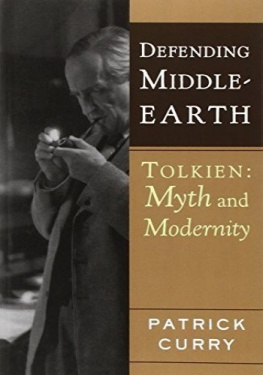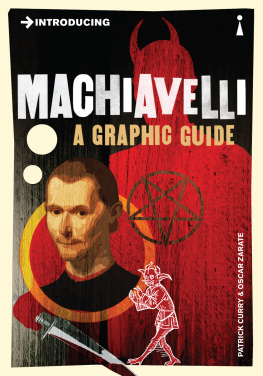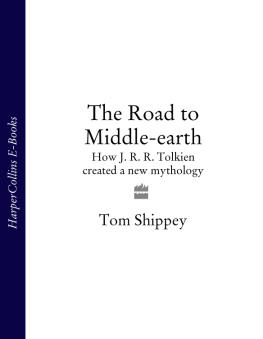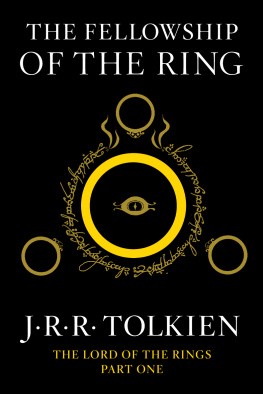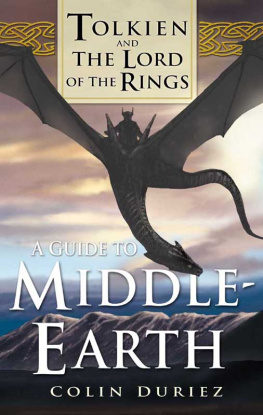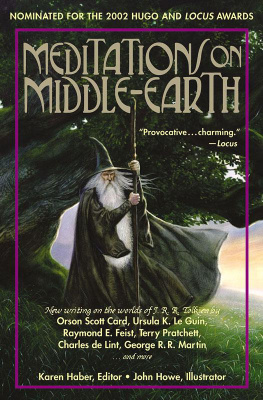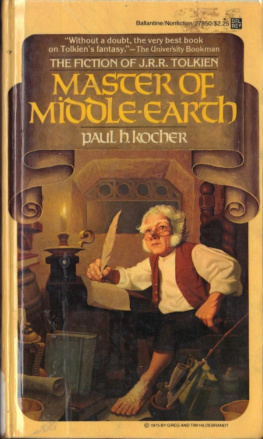First Houghton Mifflin Books edition 2004
Copyright 1997, 2004 by Patrick Curry
ALL RIGHTS RESERVED
For information about permission to reproduce selections from this book, write to Permissions, Houghton Mifflin Company, 215 Park Avenue South, New York, New York 10003.
Visit our Web site: www.houghtonmifflinbooks.com
Library of Congress Cataloging-in-Publication data is available.
ISBN 0-618-47885-x
Previously published in hardcover by St. Martin's Press
Printed in the United States of America
Book design by Victoria Hartman
MP 10 9 87 6 5 4 3 2 1
Preface
L IKE The Lord of the Rings, if in no other way, this tale too grew in the telling. It began life as what was intended to be a short paper for the 1992 Centenary Conference in Oxford. But I found I couldn't stop, and before long it had grown to nearly 30,000 words. Eventually, without really setting out to do so, I spent a good deal of the last five years researching and writing it. Part of the problem was that Tolkien's work impinges on so many complex and profound concerns, each with its own centrifugal tendency, that trying to exert some editorial control has been (I imagine) like riding a wild horse.
For whom is the book intended? According to Tolkien, one face of fairy-stories is 'the Mirror of scorn and pity towards Man.' Scorn and pity is certainly what I feel for one section of humanity I encountered while working on it, namely all those editors, critics and authors who look down their nose at Tolkien, usually without ever having really read or thought about him. They exhibited disturbing signs of a group 'mind' based entirely on snobbery and prejudice. I would therefore be astounded, albeit pleasantly so, if my book persuades any of them otherwise; but in any case, it is not really meant for them. May it rather provide a way in for those who come to Tolkien's books with an open mind, send former readers back to them again, and help those who already love them to appreciate them still more. (And if any of the latter have felt ashamed to admit it, may it help you understand why you need do so no longer!)
I may as well also mention that alongside this book another text has sprung up willy-nilly. Too long for an article, too short for a bookalthough still growingit takes the via negativa of tackling Tolkien's Marxist, modernist, feminist and psychoanalytic critics directly. This enables some things to be discussed that were not appropriate to include here. I am thinking of calling it something like, 'The Discursive Dynamics of Tolkien's Fantasy: A Post-Axiological Critique,' and seeing what happens. (Academic editors: please confound my expectations, and form an orderly queue.)
As a result of my experience with the 'experts' to date, I am all the more grateful to Christopher Moore, of Floris Books, for his thorough, sensitive and patient editorial guidance; and to Suzanna Curry, for her support, wisdom and forbearance. They have made it a much better book than it would have otherwise been.
It is also a pleasure to thank these others who have helped. Michael Winship, Clay Ramsay, Jesper Siberg, Virginia Luling, Simon Schaffer, Elaine Jordan, John Seed and Angus Clarke read and commented on early drafts. Stratford Caldecott, Tony Linsell, Kathleen Herbert, Charles Coulombe, Raphael Samuel, Dwayne Thorpe, Ray Keenoy and my mother, Noreen Curry, provided valuable moral support and encouragement in discussions or correspondence. Tom Shippey, Ursula Le Guin and Brian Attebery also made encouraging noises early on in correspondence, which I greatly appreciated. Charles Noad kindly read the whole penultimate draft and saved me from many small and some not-so-small errors; so did Nicola Bown, who made some excellent suggestions. (None of these people, obviously, have any responsibility for what I have finally said.)
I would also like to thank Warwick and Linda of the Q.E.L. Cafe, in Notting Hill Gate, for their hospitality; and Skrt, Filip and Karel of the Brno Tolkien Society, whom I met in Oxford in 1992, for reminding me what it's all about. (May you too be lucky enough to be reminded, when you have almost forgotten.)
I am also grateful to HarperCollins UK for permission to quote from the published works of J.R.R. Tolkien.
Finally, this book is dedicated to the memories of three people, very different but all with a place in my heart, who died while I was still writing it: my father, Peter D. Curry (19121996), the writer P. L. Travers (18991996), and the historian Raphael Samuel (19341996). R.I.P.
1. Introduction: Radical Nostalgia
People who like this sort of thing will find this the sort of thing they like.
IT COULD BE a literary fairy-story. A reclusive Oxford don, best-known for his scholarly work on Anglo-Saxon, unexpectedly produces a popular children's story. Seventeen years later, he follows this up with a very long story, published in three volumes. Set entirely in an imaginary world, it centres on a quest involving a magic ring and some members of a three-and-a-half-foot-tall rustic race called 'hobbits.' His book is variously described as romantic epic or juvenile fantasy; but whatever it is, it is certainly not a modern novel, and the critics are divided between bafflement and visceral dislike. The general opinion in the academic and critical neighbourhood is that, rather like one of his characters, its author, 'who had always been rather cracked, had at last gone quite mad...' Yet just over ten years later, his books become runaway bestsellers; and after forty years, they count among the most widely read in the global history of publishing.
The author is, of course, John Ronald Reuel Tolkien (18921973). Born in South Africa to English parents, he moved back to England, just outside Birmingham, at the age of three-and-a-half. He developed a childhood passion for languages into a lifelong academic career, interrupted by service in the war of 191418. He became Professor first of Anglo-Saxon, then of English Language and Literature, at Oxford, where he remained for the rest of his life. Despite co-editing a respected edition of Sir Gawain and the Green Knight, and writing a paper on Beowulf acclaimed for its brilliance, it was an unremarkable life by many standards ... except for those books.
Reliable figures are hard to come by, but as far as I can tell, total worldwide sales of Tolkien's books are as follows. The Lord of the Rings(195455), at about 50 million copies, is probably the biggest-selling single work of fiction this century. The Hobbit(1937) is not far behind, at between 35 and 40 million copies. And one could add the considerable sales, now perhaps over 2 million, of his dark and difficult posthumously published epic The Silmarillion(1977). The grand total is thus well on its way to 100 million. Tolkien's books have been translated into more than thirty languages, including Japanese, Catalan, Estonian, Greek, Hebrew, Finnish, Indonesian and Vietnamese. (This last, unofficial translation appeared in 1967, whereupon the South Vietnamese II Corps was rather perceptively fted by tribesmen with shields bearing the Eye of Sauron.)
Furthermore, this is no flash-in-the-pan phenomenon, riding on the heels of the 1960s; Tolkien has outlived the counter-culture in which he first flourished. No longer fashionable, he nonetheless still sells steadily. That was undoubtedly the main reason for the purchase in 1990 of his publisher, Unwin Hyman (originally George Allen and Unwin), by HarperCollins.
Every other index points to the same conclusion. In England, for example, since figures began to be kept in 1991, Tolkien's books have been taken out of public libraries around 200,000 times a year; he is one of only four 'classic authors' whose annual lending totals have exceeded 300,000 (well ahead of Austen, Dickens and Shakespeare).
Next page
